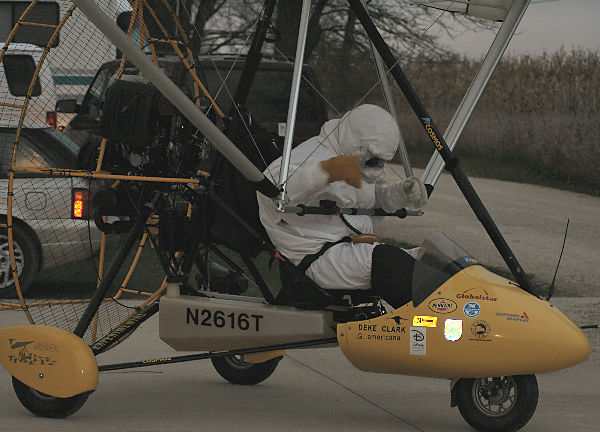Brrrrr! It's COLD Up There!
 |
Pilot Joe Duff wrote in his flight journal: The longer it takes us to reach the southern states, the colder the mornings.
On flight days the wind racing by at 35 mph (or more!) begins to eat away at your body-heat reserves, so dressing warmly is critical. Each of us has our own methods of maintaining body heat, but:
- It all starts with long johns under our flight suits. (Fleece jackets, snowmobile suits, parkas and other warm clothes can go over that.) The costume is always the outer layer.
-
We wear insulated waterproof boots and keep hand warmers inside heavy mitts stuffed in fleece-lined gauntlets attached to the control bar. (The hard part is when you have to remove the mitts to adjust the GPS or use the camera.)
After
Landing: Sometimes Too HOT!
If the winds are good and we can over fly a stop, we are generally
airborne for 2 hours. After we land, we lead the birds off to
an isolated spot until the ground crew arrives and gets the pen
set
up. If we have flown for 2 hours, that generally means they have
to drive for 3 after packing up the pen at the last site. The
set up at the new location takes roughly an hour, so the birds
are
not secured until sometime in the early afternoon.
By this time (if we're farther south) it is often 70 degrees
and we pilots are still dressed for sub zero conditions. If you
pull
your arms
inside
the
costume, you can begin to remove some layers if you are desperate.
I often
speculate about what the birds think when their 'parents'
begin to convulse and contort while standing ankle deep in mud.
Put on several layers of warm clothing. Top it off by putting a sheet or blanket over it all, rather like the costume the pilots wear. Now try taking off some layers without letting the watching crane-kids see that you are a human under all those layers!
|
|
Richard
puts on the layers.
Photo Heather Ray, Operation Migration |
Journey North is pleased to feature this educational
adventure made possible by the
Whooping Crane Eastern Partnership (WCEP).



